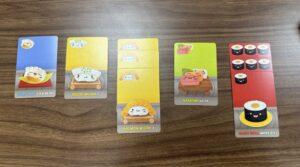Sushi Go! is a card game designed by Phil Walker-Harding and published by Gamewright Games. Sushi Go! is also available as an app for iOS/Android and can also be played online. Last night, I was able to play Sushi Go! with a party of 3 (including me). We were able to get a physical copy since Jenny was gifted a set from her relatives for Christmas. The intended audience for Sushi Go! is ages 8 and older, which is fitting since procedures of the game are straightforward and easy to pick up.
The goal of Sushi Go! is to collect the highest number of points by collecting various sushi dishes as players draft cards. In this card drafting mechanic, players simultaneously choose one card to keep and pass the remaining cards to the next player. This continues until all the cards have been drafted. Players then score points based on the types of sushi they collected and how many they were able to collect of each kind. Each card has special conditions in order to collect its points.

[one round of Sushi GO! that totaled up to 16 points]
Our intended game for project two is a card game named “Works of Art”. The objective of our game is to build an art collection that yields the highest value at the end of the game. To do so, players can choose to collect valuable artworks, or aim to collect artworks of the same sets to gain bonuses. One caveat is that players must be wary of counterfeits when buying/trading paintings with each other. Counterfeits are identified using connoisseur cards that allows them to gain insider insight on certain sets of paintings.
While both Sushi Go! and Works of Art share similar mechanics and objectives such that both games center around the building and valuation of a collection, Works of Art has a stronger focus in deception and fantasy through its usage of role cards, auction system, and connoisseur cards.
In Sushi Go!, players strive for the most valuable combination of sushi dishes, while Works of Art tasks players with acquiring genuine artworks that fit their collection’s theme or have high monetary value. The set building mechanic creates a dynamic of competition and manipulation in both games as players are able to see what the other players are building and take action against them if necessary (playing their card before they get to in Sushi Go!, outbidding them in auctions). A slight difference, however, is that players are working to build multiple and similar sets in Sushi Go! while players in Works of Art are encouraged to centralize their collection to one/two themes which divides competition in a different way. Moreover, both games also utilize a round-based structure that allows players to expand their collections during each turn. This mechanic in both games allow the players to participate and be engaged throughout the game rather than being stagnant as they wait for their turn, immersing them further in the Magic Circle.
Despite these similarities, there are many mechanics that set Sushi Go! and Works of Art apart. One difference is how information is handled in each game. Sushi Go! provides complete information about available cards which becomes more clear as players are passing along their hand. Works of Art introduces an element of deception through counterfeit artworks and connoisseur cards, requiring players to assess the authenticity of pieces and potentially bluff their opponents. These differences create different experience in social interaction as players in Works of Art must socialize through auctions, and trading negotiations.
Another difference to note is the intensity of the fantasy aesthetic in both games. Sushi Go! offers a light and whimsical theme around collecting sushi while Works of Art aims to delve deeper, encouraging players to become art collectors and navigate through real-life challenges that this occupation can encounter, as much of the design process for Works of Art focused on identifying elements and mechanics for role-play.
In all, both Sushi Go! and Works of Art offer enjoyable yet distinct collecting experiences. While Sushi Go! is a more fast-paced card game ideally for casual play, Works of Art is designed to be more immersive. The choice between these games depends on the desired gameplay experience, with Sushi Go! catering to quick, light competition and Works of Art offering a deeper strategic adventure with a touch of deception.



